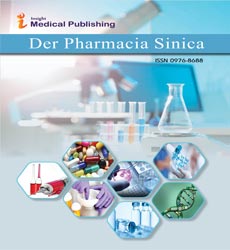ISSN : 0976 - 8688
Der Pharmacia Sinica
Phytochemical Analysis and Pharmacological Potential of Traditional Medicinal Plants: An Integrative Approach
Liang Zhao*
Department of Pharmaceutical Chemistry, Peking University Health Science Center, Beijing, China
*Corresponding author:
Liang Zhao,
Department of Pharmaceutical Chemistry, Peking University Health Science Center, Beijing, China,
E-mail: liang.zho@edu.cn
Received date: January 02, 2025, Manuscript No. ipdps-25-20774; Editor assigned date: January 04, 2025, PreQC No. ipdps-25-20774 (PQ); Reviewed date: January 18, 2025, QC No. ipdps-25-20774; Revised date: January 24, 2025, Manuscript No. ipdps-25-20774 (R); Published date: January 31, 2025, DOI: 10.36648/2470-6973.16.01.01
Citation: Zhao L (2025) Phytochemical Analysis and Pharmacological Potential of Traditional Medicinal Plants: An Integrative Approach. Der Pharmacia Sinica Vol.16.No.01: 01
Introduction
Phytochemical analysis forms the foundation of exploring medicinal plants for bioactive compounds. Plants synthesize a diverse array of secondary metabolites, including alkaloids, flavonoids, terpenoids, saponins, tannins, and phenolic compounds, which contribute to their medicinal properties. Techniques such as High-performance Liquid Chromatography (HPLC), Gas Chromatography-mass Spectrometry (GC-MS), Liquid Chromatography-tandem Mass Spectrometry (LC-MS/MS), and nuclear magnetic resonance (NMR) spectroscopy enable precise identification and quantification of these compounds. Modern metabolomics approaches allow for the profiling of entire phytochemical spectra, providing a holistic understanding of plant chemistry. By combining traditional extraction methods with advanced analytical tools, researchers can identify the most pharmacologically relevant [1].
Description
The pharmacological potential of traditional medicinal plants extends across a wide range of biological activities. Experimental studies have demonstrated antioxidant, anti-inflammatory, antimicrobial, antidiabetic, neuroprotective, and anticancer properties in numerous plant species. For example, polyphenols and flavonoids are known for their radical scavenging activity, contributing to the prevention of oxidative stress-related diseases. Alkaloids and terpenoids exhibit potent antimicrobial and anticancer effects, often through modulation of cellular signaling pathways. Integrative studies combine in vitro assays, such as enzyme inhibition and cytotoxicity tests, with in vivo animal models to validate these pharmacological effects. The synergy between multiple phytochemicals in a single plant often enhances therapeutic efficacy, highlighting the importance of studying whole extracts in addition to isolated compounds. Traditional medicinal plants have been used for centuries across cultures for the prevention and treatment of various ailments [2].
Ethnopharmacology plays a critical role in guiding phytochemical and pharmacological investigations. Traditional knowledge systems, accumulated over generations, provide insights into plant selection, preparation, and therapeutic use. By integrating ethnobotanical surveys with modern analytical techniques, researchers can prioritize plants with a high likelihood of bioactivity. Computational tools, such as network pharmacology and molecular docking, further enhance this integrative approach by predicting interactions between phytochemicals and biological targets. These methodologies not only streamline experimental efforts but also uncover multi-target mechanisms of action, which are particularly relevant for complex diseases like diabetes, cancer, and neurodegenerative disorders. Thus, combining traditional wisdom with scientific rigor creates a robust platform for drug discovery and development [3].
The application of an integrative approach also addresses challenges related to standardization, safety, and efficacy. Variability in phytochemical content due to environmental factors, harvesting conditions, and plant part selection can significantly affect therapeutic outcomes. Quantitative phytochemical profiling ensures consistency and enables the development of standardized extracts for clinical use. Toxicological assessments, including acute, sub-chronic, and chronic studies, are essential to evaluate safety and establish dosage parameters. Furthermore, clinical trials provide evidence for efficacy and tolerability in human populations, bridging the gap between laboratory research and real-world application. The integration of analytical, pharmacological, and clinical data is crucial for translating traditional medicinal plants into validated therapeutic agent. Phytochemical analysis, combined with pharmacological evaluation, offers a comprehensive framework to elucidate the active constituents and validate their biological potential. Such an approach not only bridges ethnobotanical knowledge with modern science but also facilitates the discovery of novel therapeutic agents [4,5].
Conclusion
The integrative approach to studying traditional medicinal plants-combining phytochemical analysis with pharmacological evaluation-offers a comprehensive pathway for understanding and harnessing their therapeutic potential. By elucidating active compounds, validating biological effects, and incorporating ethnopharmacological insights, researchers can identify promising candidates for drug development. Standardization, safety assessment, and clinical validation further enhance the translational value of these studies. As interest in natural products continues to grow, this integrative framework not only preserves traditional knowledge but also drives innovation in modern medicine. Ultimately, phytochemical analysis and pharmacological research together provide a sustainable and scientifically grounded approach to discovering novel therapeutic agents from natureâ??s rich biodiversity.
Acknowledgement
None.
Conflict of Interest
None.
References
- Tesoriere L, Butera D, Gentile C, Livrea MA (2007). Bioactive components of caper (Capparis spinosa) from Sicily and antioxidant effects in a red meat simulated gastric digestion. J Agric Food Chem55 8465-8471.
Google Scholar Cross Ref Indexed at
- Yang T, Wang C, Liu H, Chou G, Cheng X, et al. (2010). A new antioxidant compound from Capparis spinosa. Pharm Biol48: 589-594.
Google Scholar Cross Ref Indexed at
- Celepli S, Çolak B, Sezer ÜA, Celepli P, Bigat Ä°, et al. (2022). The effects of Capparis ovata seed oil on the healing of traumatic skin wounds. Turkish Journal of Trauma & Emergency Surgery28: 1205.
Google Scholar Cross Ref Indexed at
- Gazioglu I, Semen S, Acar OO, Kolak U, Sen A, et al. (2020). Triterpenoids and steroids isolated from anatolian Capparis ovata and their activity on the expression of inflammatory cytokines. Pharm Biol58: 925-931.
Google Scholar Cross Ref Indexed at
- Zhu P, Wu J, Chang Z, Yang F, Zhang X, et al. (2025). Sodium alginate hydrogel loaded with Capparis spinosa extract for antimicrobial and antioxidant wound dressing applications. Int J Biol Macromol289: 138883.
Open Access Journals
- Aquaculture & Veterinary Science
- Chemistry & Chemical Sciences
- Clinical Sciences
- Engineering
- General Science
- Genetics & Molecular Biology
- Health Care & Nursing
- Immunology & Microbiology
- Materials Science
- Mathematics & Physics
- Medical Sciences
- Neurology & Psychiatry
- Oncology & Cancer Science
- Pharmaceutical Sciences
